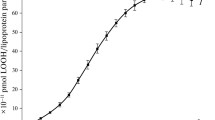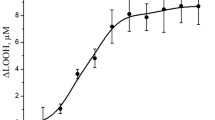Abstract
Lipoproteins isolated from human or chimpanzee serum were treated with H2O2 and allowed to stand varying lengths of time before quantitative analysis in the ultracentrifuge. Marked instability of ultracentrifugal boundaries (convection) occurred during the first 24 hr, but diminished thereafter. Simultaneously, the quantity of lipoprotein decreased. The instability of boundaries in H2O2-treated samples was presumed to reflect loss of lipid-protein affinity and breakdown of lipoproteins under the force of ultracentrifugation. Analysis of extracted lipids showed that H2O2 caused little loss of phospholipid, significant loss of triglyceride, and apparent loss of cholesteryl ester. The latter loss, however, was accompanied by appearance of esterified cholesterol in the free cholesterol eluent. Apparently H2O2 converted some cholesteryl esters to a more polar form which was eluted later from the column, with the free cholesterol fraction. Gas chromatographic analysis of the fractions eluted from the column showed that selective degradation of polyunsaturated fatty acids was most marked with cholesteryl esters, somewhat less with triglycerides, and negligible with phospholipids. It was postulated that the loss of lipid-protein affinity caused by H2O2 in vitro may reflect a similar process in vivo, i.e., that one process contributing to development of atherosclerosis can be oxidation of lipoprotein, with loss of lipid-protein affinity and accumulation of lipid products in (or on) cells of the vascular system.
Similar content being viewed by others
References
Friedman, G. D., W. B. Kannel, T. R. Dawber and P. M. McNamara, Amer. J. Epidem.,83, 366–378 (1966).
Albrink, M., Arch. Int. Med.,109, 345–359 (1962).
Gofman, J. W., W. Young and R. Tandy, Circulation34, 679–697 (1966).
Keys, A., “Atherosclerosis and its Origin,” Academic Press, New York, 1963, pp. 263–299.
Swell, L. and C. R. Treadwell, Ibid. “, pp. 301–347.
Glavind, J. and S. Hartmann, Experentia,7, 464 (1951).
Hartroft, W. S., “Metabolism of Lipids as Related to Atherosclerosis,” Charles C Thomas, Springfield, 1965, pp. 18–25.
Caravaca, J., C. Velasco and E. G. Dimond, J. Atheros. Res.,7, 355–360 (1967).
Gurd, F. R. N., “Lipid Chemistry,” John Wiley, New York, N. Y., 1960, pp. 260–325.
Ray, B. R., E. O. Davisson and H. L. Crespi, J. Am. Chem. Soc.,58, 841–846 (1954).
DeLalla, O. F. and J. W. Gofman, Methods of Biochem. Analysis,1, 459–478 (1954).
Green, A. A., L. A. Lewis and I. H. Page, Federation Proc.10, 191 (1951).
Leeder, L. G. and D. A. Clark, Microchem. J.,12, 396–408 (1967).
Morrison, W. R. and L. M. Smith, J. Lipid Res.,5, 600–608 (1964).
Metcalfe, L. D., A. A. Schmitz and J. R. Pelka, Analyt. Chem.,38, 514–515 (1966).
Rosenthal, H. L., M. L. Pfluke and S. Buscaglia, J. Lab. Clin. Med.,50, 318–322 (1957).
Sperry, W. M., and M. Webb, J. Biol. Chem.187, 97–106 (1950)
Robinson, W. L. and G. J. Nelson, JAOCS,44, 308A (1967).
McCormick, E. C., D. G. Cornwell and J. B. Brown, J. Lipid Res.,1, 221–228 (1960).
Cohen, G. and P. Hochstein, Biochem.,2, 1420–1428 (1963).
Kirk, J. E., “Atherosclerosis and its Origin,” Academic Press, New York, 1963, pp. 67–117.
Eger-Neufeldt, I., A. Teinzer, L. Weiss and O. Wieland, Biochem. Biophys. Res. Comm.,19, 43–48 (1965).
Tepperman, H. M. and J. Tepperman, Adv. in Enzyme Reg.,1, 121–136 (1963).
Garland, P. B. and P. K. Tubbs, Biochem. J.89, 25P (1963).
Author information
Authors and Affiliations
About this article
Cite this article
Clark, D.A., Foulds, E.L. & Wilson, F.H. Effects of hydrogen peroxide on lipoproteins and associated lipids. Lipids 4, 1–8 (1969). https://doi.org/10.1007/BF02531786
Received:
Issue Date:
DOI: https://doi.org/10.1007/BF02531786




